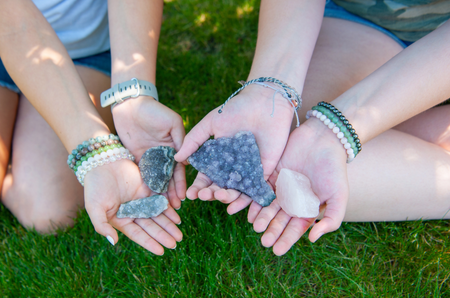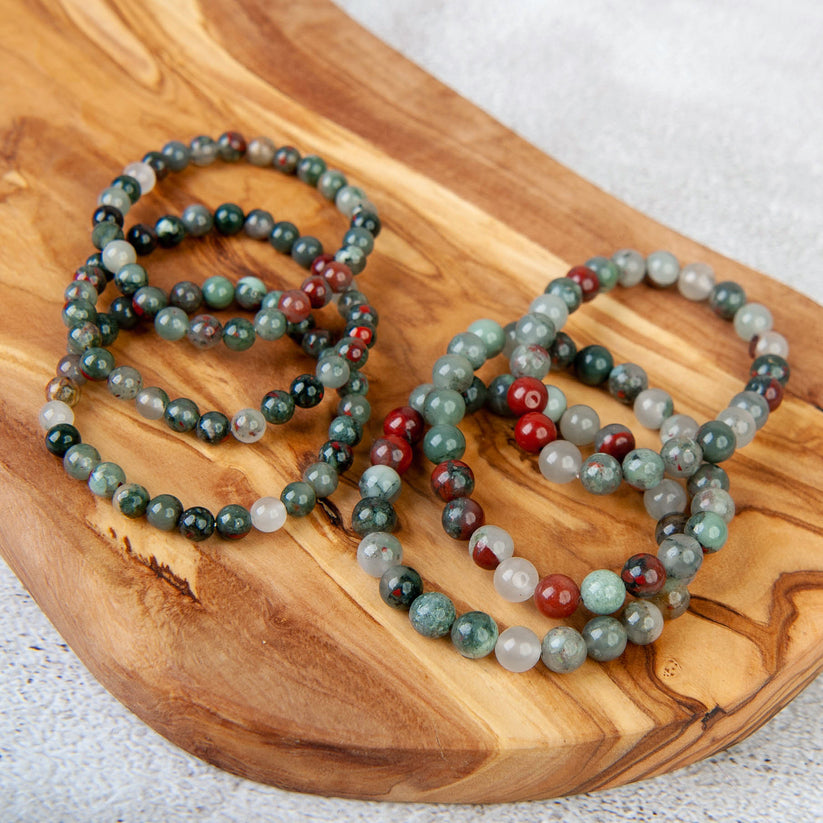What Are The 5 Characteristics Of A Rock?
Article by Rezolutions Design
$0.00 USD
FREE SCOOP OF TUMBLED STONES ON ORDERS OVER
Article by Rezolutions Design

In geology, rock (or stone) is any naturally occurring solid material composed of several minerals, elements, or both. Rocks are classified according to their origin, composition, and texture.
Rocks are the basic unit of Earth's lithosphere, which is the outermost solid layer of the planet, made up of the brittle crust and the upper mantle. The lithosphere is about 60 miles (100 kilometers) thick, although its thickness varies depending on location. It is thinnest at the mid-ocean ridge, where new crust is being created, and thickest at continental shields, where the old crust is being recycled.
Typically, the earth's crust is layered, with sedimentary rocks on top, metamorphic rocks in the center, and basaltic rocks at the bottom. These rocks (except obsidian and coal) are made of various minerals that give them their unique characteristics.
But what are these characteristics, and what do they tell us about a rock? Let's take a deep dive and explore the five most important characteristics of a rock.
5 Characteristics Of Rocks
Hardness is perhaps the most important characteristic of a rock because it is a measure of a rock's resistance to abrasion, scratching, and crushing. Hardness is also a function of a rock's mineral composition and texture.
The Mohs Scale of Hardness is the most commonly used way to measure hardness. The scale was developed in 1812 by German mineralogist Friedrich Mohs and is based on the ability of one material to scratch another. The scale is logarithmic, with each increase in hardness representing a 10-fold increase in resistance to scratching.
The Mohs Scale of Hardness goes from 1 (softest) to 10 (hardest).
Testing rock hardness involves using objects with a known hardness to scratch the surface of the rock in question. If the rock being tested is harder than the object being used to test it, then the rock will not be scratched.
The Mohs Scale of Hardness and corresponding minerals are as follows:
Talc is the softest mineral with a hardness of 1. It can be easily scratched with a fingernail. Gypsum is a little harder with a hardness of 2 and can be scratched with a copper penny. And calcite is harder still with a hardness of 3 and can be scratched with a knife blade.
At the other end of the scale, diamond is the hardest mineral, with a hardness of 10. It can only be scratched by another diamond.
So, depending on the rock's chemical composition and texture, its hardness can range from very soft to very hard. Metamorphic rocks are hard, sedimentary rocks are much softer, and igneous rocks can be either hard or soft depending on their composition.
Luster is the way a rock's surface reflects light and is an important characteristic for identifying a rock. Rocks can have two types of luster: metallic and non-metallic.
Metallic luster is shiny and looks like metal. Non-metallic luster is duller and can range from being pearly to looking like glass.
Most rocks have a non-metallic luster, but some, like gold and silver, have a metallic luster.
Though many rocks are some shade of gray, some rocks can be very colorful. The color of a rock is determined by its chemical composition. For example, the green in some rocks comes from the presence of minerals such as chlorite, while the red in other rocks comes from the presence of minerals such as hematite.
Rocks can also be a combination of colors, while some may even change color when exposed to the air or when heated.
Color is commonly used in conjunction with other characteristics, such as hardness, to help identify a rock.
The streak of a rock is its color in powder form. It is obtained by scratching the rock on an unglazed porcelain plate and rubbing the resulting powder on a white tile. The color of the powder is then compared to a chart of streak colors.
Surprisingly, two rocks can have the same color but different streak colors. For example, a rock that is green in color may have a white or pale green streak.
A rock's cleavage is the way it breaks when struck. Some rocks have a well-defined cleavage, while others do not.
Cleavage is determined by the arrangement of atoms in a rock's crystalline structure. When a rock has a well-defined cleavage, it means that its atoms are arranged in sheets that can easily slide past each other.
Rocks with a well-defined cleavage will break along these sheets, resulting in smooth, flat surfaces. Rocks without a well-defined cleavage will break in an irregular pattern.
One way to test for cleavage is to strike the rock with a hammer and observe the shape of the resulting pieces.
What are the various types of rocks and examples?
There are 3 primary types of rocks based on their formation process: Igneous, Sedimentary, and Metamorphic.
Igneous rocks are made from solidified lava or magma and include granite, obsidian, and basalt.
Sedimentary rocks are made from bits of other rocks that have been cemented together over time and include sandstone, shale, and limestone.
Metamorphic rocks are made from other rocks that have been changed by heat or pressure and include marble, slate, and gneiss.
What are the 5 characteristics of a rock?
The 5 main characteristics of rock are color, streak, cleavage, luster, and hardness. These characteristics are used to help identify a rock.
What are some uses of rocks and minerals?
Rocks and minerals are used for a variety of purposes, including construction, jewelry, and decoration. This really depends on the type of rock or mineral. For example, granite is a popular choice for countertops and flooring, while diamonds are often used in jewelry.
What is the difference between a rock and a mineral?
A rock is made up of two or more minerals, while a mineral is a naturally occurring, inorganic solid with a definite chemical composition and crystal structure.
What are the characteristics of igneous rocks?
Some characteristics of igneous rocks include:
They don't have fossil deposits
They have different sizes and shapes
They have a glassy or crystalline texture
They are formed from the solidification of magma or lava
They have a wide range of colors, depending on the minerals they contain.
Igneous rocks are classified according to their mode of formation, which includes intrusive and extrusive.
What are the characteristics of sedimentary rocks?
These rocks as softer than igneous rocks and are easily worn away.
They have a layered appearance due to the way they are formed, with sediments being deposited on top of each other over time.
They tend to be more grey or brown in color, again due to the sediments they are made from.
They often contain fossils, as they form in environments where there is a lot of plant and animal life.
There are three main types of sedimentary rocks: clastic, chemical, and organic.
What are the characteristics of metamorphic rocks?
Metamorphic rocks are hard in texture.
They have a non-layered appearance.
They are formed when rocks are subjected to high temperatures and pressures, which can change their mineral composition and structure.
They can be found in a wide range of colors, depending on the minerals they contain.
There are two main types of metamorphic rocks: foliated and non-foliated.

Sign up now and enjoy a 10% discount on your first purchase. Start your mining adventure today!
Sign up now and enjoy a 10% discount on your first purchase.
Explore
Learn
Explore
Learn
Get In Touch
Sign up now and enjoy a 10% discount on your first purchase.
© 2025 DECLAN'S MINING CO. - ALL RIGHTS RESERVED.
